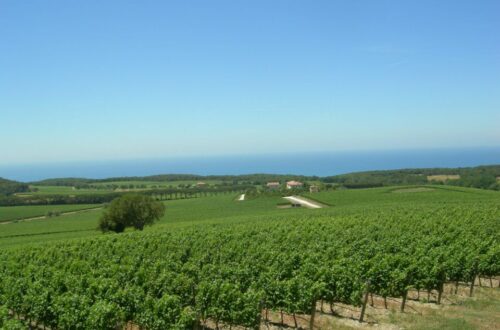Table of Contents
What is Dolcetto di Ovada Superiore DOCG?
Dolcetto di Ovada Superiore DOCG—often simply called Ovada DOCG—is one of Piedmont’s most characterful red wines. Far from the lighter, easy-drinking Dolcettos of Alba, this version is bolder, drier, and more structured, with intense cherry fruit, violet perfume, and the almond bitterness that is Dolcetto’s signature. It’s a wine of hills, heritage, and patience—requiring longer aging than most Dolcettos, and rewarding drinkers with surprising complexity.
History and Origins
The hills around Ovada, in southern Piedmont near the Ligurian border, have cultivated Dolcetto for centuries. Local archives record its presence as early as the 13th century, when Genoese traders transported the wine to Ligurian ports. “Dolcetto” means “little sweet one,” not for its sugar content (these wines are dry) but for the grape’s sweet-tasting berries. In 2008, the “Superiore” version earned DOCG status, recognizing its higher quality standards, longer aging, and deeper expression of terroir.
Where It’s Made: Geography & Terroir
Ovada’s vineyards sit at 200–500 meters above sea level, spread across rolling hills with marls, limestone, and clay-rich soils. The climate is shaped by its position between the Alps and the Ligurian Sea—warm, sunny days followed by cool nights that preserve acidity and fragrance. This combination creates wines with ripe fruit yet refreshing lift, making Ovada DOCG a standout in Dolcetto’s family.
The Grape
100% Dolcetto—no blending allowed. Compared to Dolcetto from Alba or Dogliani, Ovada’s grapes are harvested later, achieving higher ripeness and tannic structure. The berries are small and thick-skinned, giving concentrated flavors and a deep ruby-purple hue.
Winemaking & DOCG Regulations
Ovada DOCG is always red, always still, and must follow strict rules:
| Requirement | Ovada DOCG Standard |
| Grape Variety | 100% Dolcetto |
| Minimum Alcohol | 12.5% |
| Minimum Aging | 12 months before release (Superiore) |
| Riserva Aging | 20 months minimum |
| Vineyard Yield | Max 7 tonnes/ha |
Fermentation typically takes place in stainless steel or concrete to preserve varietal purity, with some producers using large Slavonian oak for gentle maturation.
Key Facts at a Glance
- Region: Piedmont, Italy
- Subzone: Ovada, Alessandria Province
- Style: Bold, dry, structured red wine
- Best Drinking Window: 3–8 years from vintage
- Notable Producers: Villa Sparina, La Casaccia, Rocca Rondinaria, Tenuta Gaggino
Tasting Notes
- Appearance: Deep ruby with purple highlights
- Nose: Black cherry, plum, violets, almond, and hints of licorice
- Palate: Medium-full bodied, fine tannins, balanced acidity, subtle earthy spice
- Finish: Dry, almond-kissed, lingering
Serving & Pairing
Serve at 16–18°C (60–64°F) in a Bordeaux-style glass.
Perfect Pairings:
- Pasta & Meat: Tagliatelle with ragù, rabbit stew (coniglio alla ligure)
- Cheese: Aged toma, Castelmagno, Pecorino
- Vegetarian: Mushroom risotto, roasted peppers with anchovies
Where to Buy & Pricing
Dolcetto di Ovada Superiore DOCG offers excellent value—often $18–$35 USD for top bottles. Look for reputable Italian wine shops, online retailers like Wine.com or Vivino, or importers specializing in Piedmont wines.
Top 5 Bottles to Try in 2025
- Rocca Rondinaria “Vigneto La Ghiaia” – Concentrated and age-worthy
- La Casaccia Superiore – Elegant and floral, ideal with lamb
- Tenuta Gaggino Riserva – Power meets finesse
- Poggio di Carpineto Ovada – Smooth and approachable
- Cascina Gentile Superiore – Classic style, great value
FAQ on Dolcetto di Ovada Superiore DOCG
Is Dolcetto di Ovada sweet?
No—despite the name, it is dry with almond bitterness.
How does it compare to Dolcetto d’Alba?
Ovada is fuller-bodied, more structured, and longer-lived.
Can I age Dolcetto di Ovada?
Yes—Superiore and Riserva versions can age 5–10 years, developing complexity.
Fun Facts & Cultural Notes
- The Ligurian influence means Ovada Dolcetto often pairs beautifully with seafood pastas—rare for a red.
- Many producers still practice hand-harvesting on steep slopes, preserving artisanal tradition.
- Ovada’s DOCG status was among the last awarded to a Dolcetto zone, highlighting its unique late-ripening potential.
Call to Action for Audience Engagement:
Have you ever tried Dolcetto di Ovada Superiore? Share your tasting notes and favorite pairings with us on Instagram @DrinkItalian, and you might be featured in our next wine spotlight!


